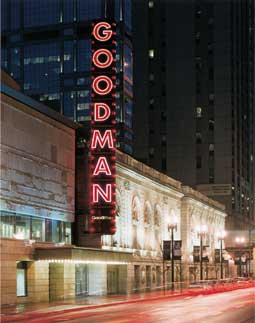John Logan's Six-Time Tony Award Winning Red set for Goodman Theatre

Goodman Theatre's 2011/2012 Season comes to life with Red, John Logan's "sizzling, intellectually thrilling" (Chicago Tribune) journey into the mind of Abstract Expressionist Mark Rothko. Goodman Theatre Artistic Director Robert Falls helms this Chicago premiere and first major original American production of Red, featuring Edward Gero as Rothko and Chicago's own Patrick Andrews as Ken, his young assistant. Logan's six-time Tony Award-winning play has quickly become among the most acclaimed dramas of the past decade, critically hailed in London and on Broadway as an "electrifying play of ideas" (Variety) and an "engrossing, often enthralling new play about art, an artist and the act of creation" (Associated Press).
"It's an enormous pleasure to welcome John Logan back to the city where he launched his distinguished career," said Artistic Director Robert Falls. "I have enjoyed a personal and professional friendship with John since our collaboration on Riverview: A Melodrama with Music more than 20 years ago. It is with great pride that we begin our 2011/2012 Season with his extraordinarily passionate and moving work."
John Logan began his playwrighting career in Chicago after graduating from Northwestern University. He has authored of more than a dozen plays, including Never the Sinner and Hauptmann, as well as a successful screenwriter with film credits including Gladiator, The Aviator (both nominated for an Academy Award) and Sweeney Todd: The Demon Barber of Fleet Street.
"I always knew I wanted the first major original American production of Red to take place in Chicago, the city where I was 'Ken'-an aspiring artist just starting out in a thrilling time of talent and opportunity," said Logan. "Bob Falls' muscularity as a director, to me, parallels Rothko's muscularity as an artist and man. Bob is so profoundly moved by art-theatrical art, visual art, literary art-there was never a question that he was the director for this production."
"There is only one thing in life I fear, my friend...one day the black will swallow the red" (Mark Rothko). Red is a snapshot of the enigmatic and conflicted painter (portrayed by Edward Gero) and his personal and generational struggles at a seminal moment in his career: his 1958 commission to create a series of murals for New York's upscale Four Seasons restaurant in the Seagram Building. While Rothko was exhilarated by the free reign given by his commissioners, he faced a number of challenges-including a prospective audience that he had professed to scorn. This emotionally and creatively charged event is the basis for Red, in which Logan pairs Rothko with Ken (Patrick Andrews), a fictitious young assistant and aspiring artist who must choose between appeasing his mentor and changing the course of art history.
Widely considered one of the most influential artists of the twentieth century, Mark Rothko was an Abstract Expressionist painter and a fiercely intellectual art theorist. "I think of my pictures as dramas; the shapes in the pictures are the performers," said Rothko. "Like actors, the shapes create and resolve tension, bringing a painting equilibrium in the same way that a novelist or playwright sets characters in motion and eventually offers resolution." A Jewish immigrant from Dvinsk, Russia, Rothko constantly battled feelings of ostracism and rejection; even at the height of his career, he feared that critics, curators and the public misunderstood his work. When Logan first encountered Rothko's Seagram-commissioned murals at the Tate Modern in London, he was struck by the strong energy he felt while viewing the bold canvases and intrigued that the murals were never displayed in the Four Seasons restaurant. "Studying Rothko and learning about his technique was like learning a new language for me- the language of visual art," said Logan, who applied that language to the characters of Rothko and Ken in Red. "I think audiences respond to the flamboyant grandeur and intensity of the character, but what really moves them is the father-son relationship between these two men. To me the play is really not about art or painting at all; it's about fathers and sons."
